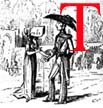 hose poets who had some connection with the Pre-Raphaelite circle include Christina Rossetti, Dante Gabriel Rossetti, George Meredith, William Morris, and Algernon Charles Swinburne. Pre-Raphaelitism in poetry had major influence upon the writers of the Decadence of the 1890s, such as Ernest Dowson, Lionel Johnson, Michael Field, and Oscar Wilde, as well as upon Gerard Manley Hopkins and William Butler Yeats, both of whom were influenced by John Ruskin and visual Pre-Raphaelitism.
hose poets who had some connection with the Pre-Raphaelite circle include Christina Rossetti, Dante Gabriel Rossetti, George Meredith, William Morris, and Algernon Charles Swinburne. Pre-Raphaelitism in poetry had major influence upon the writers of the Decadence of the 1890s, such as Ernest Dowson, Lionel Johnson, Michael Field, and Oscar Wilde, as well as upon Gerard Manley Hopkins and William Butler Yeats, both of whom were influenced by John Ruskin and visual Pre-Raphaelitism.
Pre-Raphaelitism in painting had two forms or stages, first, the hard-edge symbolic naturalism of the Pre-Raphaelite Brotherhood that began in 1849 and, second, the moody, erotic medievalism that took form in the later 1850s. Many critics imply that only this second, or Aesthetic, Pre-Raphaelitism has relevance to poetry. In fact, although the combination of realistic style with elaborate symbolism that distinguishes the early movement appears in a few poems, particularly in those by James Collinson and the Rossettis, this second stage finally had the largest -- at least the most easily noticeable -- influence on literature.
As Anthony Harrison points out in his study of Christina Rossetti,
the Pre-Raphaelites predictably etherealized sensation, displacing it from logical contexts and all normally expected physical relations with objects in the external world. With the Pre-Raphaelites the sensory and even the sensual become idealized, image becomes symbol, and physical experience is superseded by mental states as we are thrust deeply into the self-contained emotional worlds of their varied personae. Very seldom do we have even the implied auditor of Browning's dramatic monologues to give us our bearings, to situate a speaker's perceptions in the phenomenal world. In this respect Pre-Raphaelite poems resemble many from the first two volumes of their much-admired Tennyson (especially "Mariana," "The Lotos-Eaters," "The Palace of Art," and "Oenone"). However, unlike his Pre-Raphaelite emulators, Tennyson, after In Memoriam, for the most part rejected predominantly aesthetic poetry. [Christina Rossetti in Context]
Nonetheless, if one looks for a poet whose work parallels the artistic project of the Pre-Raphaelite Brotherhood, one immediately notices Robert Browning , whose work was enormously popular with them all and a particular influence on Rossetti, who wrote out Pauline (1833) from the British Museum copy. Like the paintings of the Brotherhood, Browning's poems simultaneously extend the boundaries of subject and create a kind of abrasive realism, and like the work of the young painters, his also employ elaborate symbolism drawn from biblical types to carry the audience beyond the aesthetic surface, to which he, like the painters, aggressively draws attention. One must mention the Browningesque element in Pre-Raphaelite poetry because it appears intermittently all the way up to Hopkins in self-consciously difficult language, the dramatic monologue, and elaborate applications of biblical typology.
Aesthetic Pre-Raphaelitism, nonetheless, has most in common with the poets of this group, all of whom draw upon the poetic continuum that descends from Spenser through Keats and Tennyson -- upon the poetic line, in other words, that emphasizes lush vowel sounds, sensuous description, subjective psychological states, elaborate personification, and complex poetic forms, such as the sestina, borrowed from Italian and Provençal love poetry.
Related material
Last modified 20 October 2004